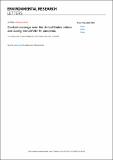Contrail coverage over the United States before and during the COVID-19 pandemic
Author(s)
Meijer, Vincent R; Kulik, Luke; Eastham, Sebastian D; Allroggen, Florian; Speth, Raymond L; Karaman, Sertac; Barrett, Steven RH; ... Show more Show less
DownloadPublished version (1.684Mb)
Publisher with Creative Commons License
Publisher with Creative Commons License
Creative Commons Attribution
Terms of use
Metadata
Show full item recordAbstract
<jats:title>Abstract</jats:title>
<jats:p>Contrails are potentially the largest contributor to aviation-attributable climate change, but estimates of their coverage are highly uncertain. No study has provided observation-based continental-scale estimates of the diurnal, seasonal, and regional variability in contrail coverage. We present contrail coverage estimates for the years 2018, 2019 and 2020 for the contiguous United States, derived by developing and applying a deep learning algorithm to over 100 000 satellite images. We estimate that contrails covered an area the size of Massachusetts and Connecticut combined in the years 2018 and 2019. Comparing 2019 and 2020, we quantify a 35.8% reduction in distance flown above 8 km altitude and an associated reduction in contrail coverage of 22.3%. We also find that the diurnal pattern in contrail coverage aligns with that of flight traffic, but that the amount of contrail coverage per distance flown decreases in the afternoon.</jats:p>
Date issued
2022Department
Massachusetts Institute of Technology. Department of Aeronautics and Astronautics; Massachusetts Institute of Technology. Laboratory for Aviation and the Environment; Massachusetts Institute of Technology. Joint Program on the Science & Policy of Global Change; Massachusetts Institute of Technology. Laboratory for Information and Decision SystemsJournal
Environmental Research Letters
Publisher
IOP Publishing
Citation
Meijer, Vincent R, Kulik, Luke, Eastham, Sebastian D, Allroggen, Florian, Speth, Raymond L et al. 2022. "Contrail coverage over the United States before and during the COVID-19 pandemic." Environmental Research Letters, 17 (3).
Version: Final published version